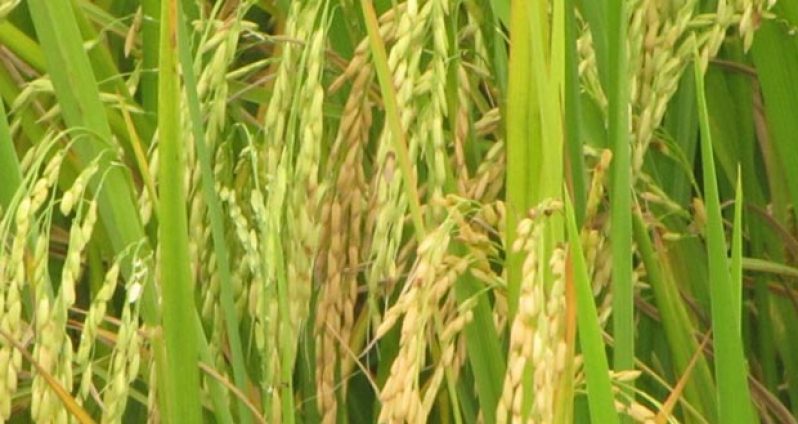… says Seeraj
THE production target for the first crop of 2014 is 270,000 tonnes, according to Head of the Guyana Rice Producers Association (RPA), Dharamkumar Seeraj.

And he maintains that in building on the successes of the RPA and the rice sector, 2014 will see better coordination in the push for increased expansion.
Seeraj told the Guyana Chronicle that 2013 was a good year for the RPA, particularly as it relates to the engagement with farmers.
He said: “We are encouraging more farmers to take advantage of our field days, demonstrations and other activities.
“What we saw in the production for 2013 was the impact of better agronomical practices and increased extension service…we hope to build on this in the New Year.”
The extension service essentially is expected to build partnerships and provide research-based information through non-formal education to farmers in order to help them improve their economic wellbeing and way of life.
The RPA General Secretary also lauded the support of the Ministry of Agriculture’s Rice Development Board (GRDB).
“We had good production, good quality and a good year on the whole,” Seeraj said.
SEEKING NEW MARKETS
Meanwhile, he acknowledged that the successes recorded in 2013 were not achieved without challenges in the sector.
He said: “The death of President Hugo Chavez introduced some problems in terms of marketing but thankfully that was settled.
“What this incident did was reinforce the risks we face in terms of exporting our rice, so this year the focus has to be on spreading that risk by making sure we have new markets in the Caribbean, Europe and Latin America.
In a prior interview with this newspaper, Agriculture Minister, Dr. Leslie Ramsammy noted that a three-pronged approach is being taken to increase exports in the rice sector: increasing the market share in countries that have agreements with Guyana; re-entering old markets where the country once had a meaningful presence; and securing new markets.
Ramsammy stated that efforts are underway to have not only Venezuela, but Jamaica and Trinidad and Tobago as well as countries in Europe review existing agreements for paddy and rice exports.
Minister Ramsammy explained that the Caribbean countries and Venezuela currently import rice from other countries, in addition to Guyana, and there is an opportunity to secure greater shares in these existing markets.
He pointed out that in the case of Haiti, since the earthquake that devastated the nation’s capital, much of the rice entering the country was in the form of aid, but with the country in a position to purchase their own rice, Guyana can take advantage of this market.
According to him, Guyana is talking to several other new countries to secure export agreements.
Ramsammy contends that the promotion of private sector to private sector agreements is another way to boost Guyana’s rice exports.
Seeraj added that RPA also had to deal with the challenge of capacity and the need for its improvement to respond to the increasing production.
“The challenges we saw in 2013, despite the great successes, will better position us as we move forward,” he said.
Seeraj also stressed the need for farmers to desist from certain practices that could see them left at a disadvantage.
The RPA Head said: “One of the problems we have is farmers taking up undeclared drainage and irrigation land, a practice that can expose crops to flooding or drought.
“The other issue is the fact that some farmers are taking up lands zoned for cattle rearing, in particular in Region 6 (East Berbice) and we cannot have this continue.”
He also warned against illegal tampering of drainage and irrigation structures.
“This is the RPA sounding a warning and we are hoping that farmers cooperate with us,” Seeraj said.
NEXT MOVE
Asked about work in the New Year, he gave assurance of the RPA’s increased and continued commitment to advancing the rice sector in 2014. Seeraj also reiterated the intended focus on better coordination in the expansion thrust.
“We will continue our work and continue representing farmers to advance the sector,” Seeraj said.
RPA represents and advances the interest of close to 6,000 rice farmers across Guyana.
Established in 1946 the RPA’s primary aim is to promote the interest of rice producers and is one of the oldest non-governmental organisations (NGO) in Guyana. Its development partners include the Caribbean Policy Development Centre, the Caribbean Farmers Network and agriculture societies in Barbados, Jamaica and Trinidad and Tobago, as well as Oxfam.
The RPA, Seeraj agreed, has proven itself to be, over the years, integral to the processes that have advanced the agriculture sector – over a period of some 65 years.
Rice production occurs along the coastal belt of Guyana, utilising over 176,000 acres of land per annum and has replaced sugar as the country’s foremost productive sector and contributor to the local economy.
(By Vanessa Narine)



.jpg)









